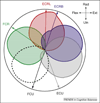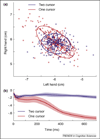The coordination of movement: optimal feedback control and beyond
- PMID: 20005767
- PMCID: PMC4350769
- DOI: 10.1016/j.tics.2009.11.004
The coordination of movement: optimal feedback control and beyond
Abstract
Optimal control theory and its more recent extension, optimal feedback control theory, provide valuable insights into the flexible and task-dependent control of movements. Here, we focus on the problem of coordination, defined as movements that involve multiple effectors (muscles, joints or limbs). Optimal control theory makes quantitative predictions concerning the distribution of work across multiple effectors. Optimal feedback control theory further predicts variation in feedback control with changes in task demands and the correlation structure between different effectors. We highlight two crucial areas of research, hierarchical control and the problem of movement initiation, that need to be developed for an optimal feedback control theory framework to characterise movement coordination more fully and to serve as a basis for studying the neural mechanisms involved in voluntary motor control.
Figures




Similar articles
-
Optimality principles in sensorimotor control.Nat Neurosci. 2004 Sep;7(9):907-15. doi: 10.1038/nn1309. Nat Neurosci. 2004. PMID: 15332089 Free PMC article. Review.
-
Optimal feedback control as a theory of motor coordination.Nat Neurosci. 2002 Nov;5(11):1226-35. doi: 10.1038/nn963. Nat Neurosci. 2002. PMID: 12404008
-
Movement duration, Fitts's law, and an infinite-horizon optimal feedback control model for biological motor systems.Neural Comput. 2013 Mar;25(3):697-724. doi: 10.1162/NECO_a_00410. Epub 2012 Dec 28. Neural Comput. 2013. PMID: 23272916 Free PMC article.
-
The Development of Bimanual Coordination Across Toddlerhood.Monogr Soc Res Child Dev. 2019 Jun;84(2):7-147. doi: 10.1111/mono.12405. Monogr Soc Res Child Dev. 2019. PMID: 31162687 Free PMC article.
-
Probabilistic mechanisms in sensorimotor control.Novartis Found Symp. 2006;270:191-8; discussion 198-202, 232-7. Novartis Found Symp. 2006. PMID: 16649715 Review.
Cited by
-
The effect of sensory uncertainty due to amblyopia (lazy eye) on the planning and execution of visually-guided 3D reaching movements.PLoS One. 2012;7(2):e31075. doi: 10.1371/journal.pone.0031075. Epub 2012 Feb 17. PLoS One. 2012. PMID: 22363549 Free PMC article.
-
Characteristics of unintentional movements by a multijoint effector.J Mot Behav. 2015;47(4):352-61. doi: 10.1080/00222895.2014.986045. Epub 2015 Jan 7. J Mot Behav. 2015. PMID: 25565394 Free PMC article.
-
Motor control abnormalities in Parkinson's disease.Cold Spring Harb Perspect Med. 2012 Jun;2(6):a009282. doi: 10.1101/cshperspect.a009282. Cold Spring Harb Perspect Med. 2012. PMID: 22675667 Free PMC article. Review.
-
How Hinge Positioning in Cross-Country Ski Bindings Affect Exercise Efficiency, Cycle Characteristics and Muscle Coordination during Submaximal Roller Skiing.PLoS One. 2016 May 20;11(5):e0153078. doi: 10.1371/journal.pone.0153078. eCollection 2016. PLoS One. 2016. PMID: 27203597 Free PMC article.
-
Locomotor patterns change over time during walking on an uneven surface.J Exp Biol. 2019 Jul 16;222(Pt 14):jeb202093. doi: 10.1242/jeb.202093. J Exp Biol. 2019. PMID: 31253712 Free PMC article.
References
-
- Bernstein NA. The Co-Ordination and Regulation of Movement. Pergamon; 1967.
-
- Tresch MC, et al. The construction of movement by the spinal cord. Nat. Neurosci. 1999;2:162–167. - PubMed
-
- Ting LH, Macpherson JM. A limited set of muscle synergies for force control during a postural task. J. Neurophysiol. 2005;93:609–613. - PubMed
Publication types
MeSH terms
Grants and funding
LinkOut - more resources
Full Text Sources

